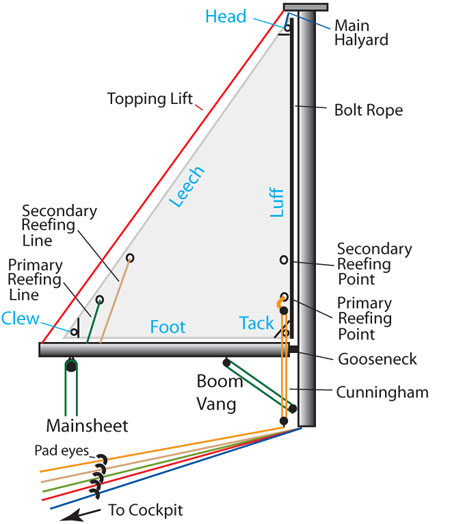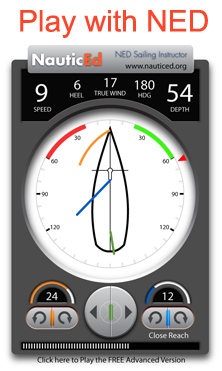This is part of a learn to sail series presented over several articles by NauticEd Sailing School. NauticEd is The World’s Most Advanced Online Sailing Education and Sailing Certification Program providing Sailing Courses for beginner to advanced sailors.
In the previous learn to sail article we discussed the basic components of the mainsail. So just when you thought you had it licked, we haven’t finished yet. There are a few more control lines for the mainsail. These are the Cunningham, the boom vang, the reefing lines and the traveler.

The Main Sail
The Cunningham is really a down haul. It is made up of two blocks, a hook and a line. It is rigidly attached to the foot of the mast and has several blocks through which the Cunningham line runs. The two blocks have multiple sheaves and thus create a lot of “purchase”, meaning that the leverage effect of multiple blocks allows the user to multiply their strength and pull down on the sail very tight if needed. The top block has a hook which hooks into an eyelet sewn into the luff (leading edge) of the mainsail. You might think that the halyard has the same effect as the Cunningham, but it doesn’t. While the halyard pulls the sail up and tensions the sail, the Cunningham has so much more power because of it’s multiple blocks that it can REALLY tighten the leading edge up when needed under high wind conditions. The Cunningham also serves as a more convenient and fine tune luff tension adjustment mechanism. Loosening and tightening the halyard would be a bit impractical. If you can’t find a Cunningham on your sailboat, don’t worry it might not have one. Cunninghams are most frequently found on racing boats when fine tuning is critical. On a cruising sailboat and especially when you are just starting out with your learn to sail quest, you won’t be needing to use it.
The boom vang also attaches to the base of the mast. The second point is about ¼ of the way along the boom. Thus it acts to pull the boom down and has the effect of tightening the leach (trailing edge) of the sail which makes the sail flatter. This is desired in high wind conditions. We’ll talk about that further on in this learn to sail series. Similar to the Cunningham, the boom vang is used for fine tuning. Most sailboats are fitted with a boom vang.
The reefing lines. There are a few different configurations on how to “Reef” the mainsail but they all have the same effect: to reduce the size of the mainsail under high wind conditions. If you have less sail area up, the forces on the boat are less, the boat heels over less and is more comfortable for the crew. As you’ll also learn later in this learn to sail series of articles, making the sail smaller can increase the speed of the boat. This sounds counter intuitive but it’s true. When you are starting out to learn to sail, it is imperative that you learn about reefing the sails. This is because you will most certainly encounter high winds, if not today then very soon. And you’ve got to know what to do.
If you don’t have a roller furling mainsail whereby the mainsail rolls up into the mast then you will be reducing the mainsail size by lowering it down a little.
The usual set up to reef the mainsail then consists of a way to pull down the luff (leading edge) of the mainsail and a way to pull down the leech (trailing edge) of the main sail. For the luff, often the Cunningham is used. It is loosened and the hook is removed from the eyelet on the mainsail luff and placed into a higher eyelet. Then the mainsail halyard is slackened to lower the mainsail a little so that the new eyelet is slightly above the boom. The halyard is then locked off and the Cunningham is tightened to pull the sail down further stretching the luff so that it is tight.
The leech now will be flapping away loose and so this must by pulled down also. You’ll see that eyelets will be sewn into the leech. Reefing lines will be attached to the boom directly below and slightly aft of the eyelet. The other end of the reefing line (if you’re lucky) will come down to the boom through a block and back along the boom close to the mast. Thus all you need to do when you have finished pulling down the Cunningham is to reach out and pull on the leech reefing line.
Most mainsails have 2 reefing positions with recommended wind speeds at which to reef. The reefing lines from the leech will be a different color so you can quickly identify which one is the first reefing position and which is the second.
If you have a roller furling mainsail, the process is much simpler. You’ll just roll the sail up a small amount to reef the sail. This is done by pulling on the inhaul while letting out the outhaul. Once the sail is reefed, lock off the inhaul and retension with the outhaul. If you try to tension with the inhaul you could damage the roller furling mechanism. This is a common mistake when people are just starting out in their learn to sail quest.
The traveler is a side to side track attached to the sailboat cabin top or in the cockpit. The mainsheet block slides into the traveler. This allows the mainsheet block to “travel” horizontally across the boat. The traveler works with the mainsheet to control what is called “twist” at the top of the leech of the mainsail.
We’ll discuss why this is necessary in follow on learn to sail a sailboat articles. You may also take the free sailing course at NauticEd which discusses basic sail trim.
So here again is a list of all the associated thingys, control lines and rigging lines for the mainsail on most sailboats. Can you match them against their function or description?
| Match the thingy versus the function/description. (print out and draw arrows to match the name and definition) |
|
| Halyard | Holds the rigging up |
| Outhaul | Controls the swing out and swing in of the boom |
| Luff | Used to hoist up the mainsail |
| Cunningham | The leading edge of the mainsail |
| Luff | Foot of the sail |
| Reefing lines | Controls twist in the top of the mainsail |
| Mainsheet | Holds the back of the boom up |
| Boom vang | Attached to the foot of the mainsail |
| Traveler | Controls the tension in the foot of the mainsail |
| Boom topping lift | The leading edge of the sail |
| Leech | Controls tension in luff of the mainsail |
| Mast | Reduces the size of the mainsail |
| Boom | Controls the flatness of the mainsail |
This article was written by Grant Headifen, Educational Director of NauticEd Sailing School. NauticEd is an online sailing school providing sailing courses and sailing certifications for beginner to advanced sailors.


